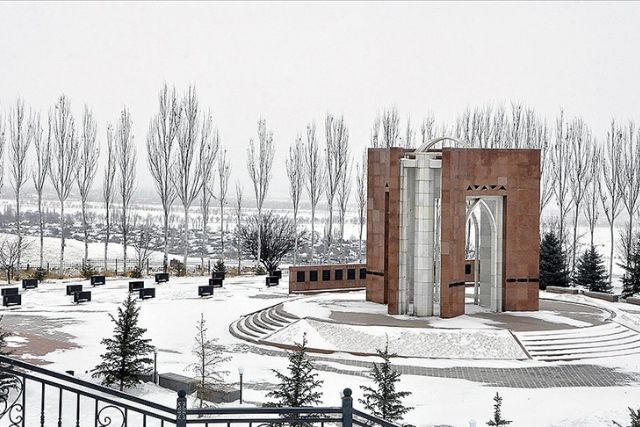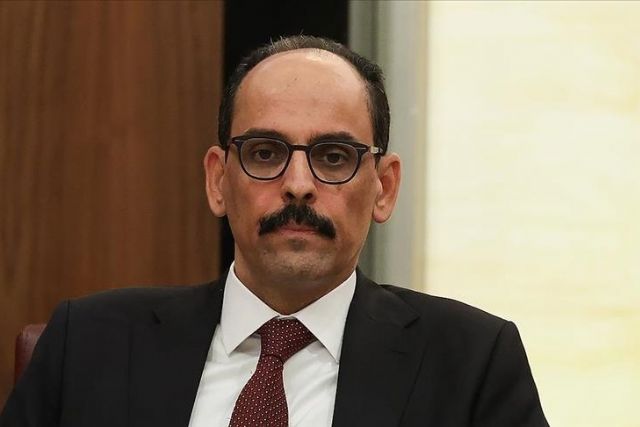Stalin’s killing of Kyrgyz intellectuals remains vivid
Graves of 138 Kyrgyz intellectuals located in Ata Beyit Memorial Complex

BISHKEK, Kyrgyzstan
The execution of 138 Kyrgyz intellectuals in 1938 by the order of the Soviet leader Joseph Stalin is still vivid in people's memories.
The graves of the intellectuals are located in the Ata Beyit Memorial Complex in the Kyrgyz village of Chong-Tash, located around 25 kilometers (15.5 miles) south of the capital Bishkek.
The complex was built in 2000 at the initiative of the country's first president, Askar Akayev, in their memory.
Speaking to Anadolu Agency, the head of the complex, Gulnara Tursunbekova, said it has turned into a spiritual center with visits by students, tourists and official delegations.
Tursunbekova said the guides at the complex are an effort to hand down the legacy of the 138 intellectuals, who pioneered the establishment of the Kyrgyz state, to the next generations.
A museum at the complex displays coins, shoes, documents, newspaper clippings, photographs and IDs unearthed from the mass grave and biographies of the victims.
The complex also features a monument called “Urkun," meaning ‘exodus,' which symbolizes the revolt by the Kyrgyz people in 1916 against their conscription into the imperial Russian army and their subsequent fleeing to China.
Through an irony of fate, world-famous Kyrgyz author and statesman Chingiz Aitmatov, who named the cemetery Ata Beyit (Grave of Our Fathers) is also buried at the cemetery.
Those who lost their lives on April 7, 2010 in the People's April Revolution are also buried at the Ata Beyit cemetery.
Ata-Beyit, where nearly all of the first Kyrgyz intellectuals are buried, is one of the first places visited by local and foreign tourists as well as foreign statesmen.
-Restoration of honor for Kyrgyz intellectuals
As the leader of a totalitarian regime, Joseph Stalin ordered the exile of millions of people from various nations after coming to power in the Soviet Union in 1924.
The architect of the Kyrgyz Latin alphabet, Kasym Tynystanov, Isenali Arabayev, who prepared the first Kyrgyz alphabet, Yusup Abdrakhmanov, who laid the foundation stone of the Kyrgyz state, Bayali Isakeyev, Imanali Aydarbekov and many others were targeted by Stalin's regime.
It was discovered 53 years later that Chingiz Aitmatov's father, then Industry and Trade Minister Torekul Aitmatov, was secretly executed by a firing squad in 1938 and buried in a mass grave in Chong-Tash village.
When the daughter of a guard who witnessed the burial by chance shared her father's will with intelligence worker Bolot Abdrahmanov after a period of 18 years, the remains of the executed people were found.
The remains of the corpses, which were found as a result of an excavation at a brick kiln in Chong-Tash village, were taken to the forensic morgue for identification.
As a result of archival research and DNA tests, it was found that the corpses of 138 people, including one woman, belonged to the intellectuals and missing persons of the period.
It was understood that the victims were killed by firing two bullets into their skulls from behind as their hands were tied behind their backs.
The official funeral was held for the victims on Aug. 30, 1991, a day before the declaration of independence of Kyrgyzstan.
With the participation of thousands of people and political leaders, the place where the intellectuals were buried was named the Ata Beyit Memorial Complex, upon the proposal of the world-renowned author Aitmatov.
After Stalin's death, the names of all of the executed Kyrgyz intellectuals -- 40 of whom were statesmen and the rest linguists and people who carried out important projects in the fields of education, economy and health -- were reinstated.
It is believed that more than 20,000 people were subjected to exile or extrajudicial executions in Kyrgyzstan during Stalin's rule.





